-
 Bitcoin
Bitcoin $107,247.2038
-0.18% -
 Ethereum
Ethereum $2,424.7947
0.34% -
 Tether USDt
Tether USDt $1.0003
-0.02% -
 XRP
XRP $2.1171
-3.33% -
 BNB
BNB $645.6618
0.06% -
 Solana
Solana $141.5898
-1.32% -
 USDC
USDC $0.9998
0.00% -
 TRON
TRON $0.2710
-0.41% -
 Dogecoin
Dogecoin $0.1602
-2.99% -
 Cardano
Cardano $0.5553
-2.28% -
 Hyperliquid
Hyperliquid $36.3019
-2.42% -
 Bitcoin Cash
Bitcoin Cash $491.7212
2.04% -
 Chainlink
Chainlink $13.0810
-0.23% -
 Sui
Sui $2.6080
-5.06% -
 UNUS SED LEO
UNUS SED LEO $9.0040
-0.05% -
 Stellar
Stellar $0.2350
-3.06% -
 Avalanche
Avalanche $17.2294
-2.31% -
 Toncoin
Toncoin $2.8075
-1.05% -
 Shiba Inu
Shiba Inu $0.0...01121
-3.43% -
 Litecoin
Litecoin $84.2215
-0.32% -
 Hedera
Hedera $0.1429
-4.88% -
 Monero
Monero $312.2199
-0.90% -
 Dai
Dai $0.9997
-0.01% -
 Ethena USDe
Ethena USDe $0.9999
-0.02% -
 Polkadot
Polkadot $3.2973
-2.60% -
 Bitget Token
Bitget Token $4.4742
3.12% -
 Pi
Pi $0.5631
-10.10% -
 Uniswap
Uniswap $6.7817
-2.06% -
 Pepe
Pepe $0.0...09252
-3.74% -
 Aave
Aave $251.3830
-2.24%
When should I leave the market after the top divergence of the RSI indicator?
RSI top divergence signals weakening bullish momentum, suggesting a potential price reversal when price makes higher highs but RSI makes lower highs.
Jun 26, 2025 at 10:49 pm
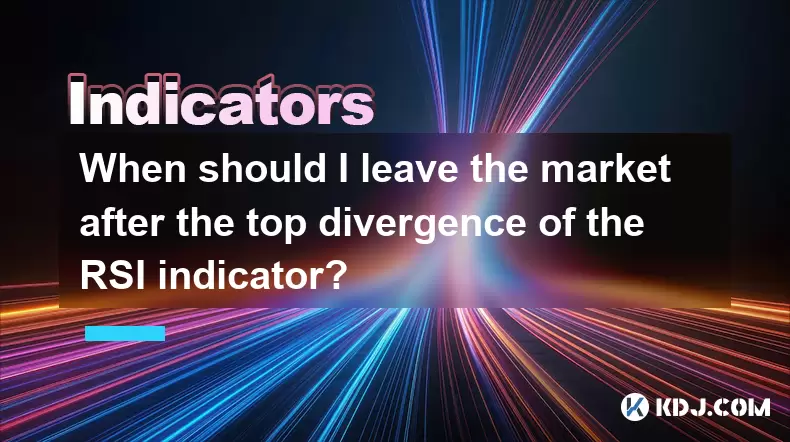
Understanding RSI Top Divergence
The Relative Strength Index (RSI) is a momentum oscillator used in technical analysis to measure the speed and change of price movements. When the RSI forms a top divergence, it indicates a potential reversal in price direction. A top divergence occurs when the price makes a higher high, but the RSI makes a lower high. This signals weakening momentum and suggests that bullish pressure may be fading.
It's crucial to recognize that RSI top divergence alone isn't a sell signal. It serves as a warning sign rather than a definitive instruction to exit positions. Traders must combine this information with other confirming indicators or chart patterns before making decisions.
Important: Always assess volume, candlestick formations, and support/resistance levels alongside RSI divergences.
Identifying Confirmation Signals
After observing an RSI top divergence, traders should look for additional confirmation signals before deciding to leave the market. These can include:
- Bearish candlestick patterns such as shooting stars, hanging men, or engulfing candles.
- Price rejection at key resistance levels where previous rallies have stalled.
- Breakdown below a major moving average, such as the 50-day or 200-day EMA.
- Volume spikes indicating increased selling pressure.
These signals help filter out false positives and increase the probability of exiting near optimal levels.
Important: Waiting for multiple confirmations reduces the risk of premature exits during strong uptrends.
Evaluating Timeframes for Exit Points
Different timeframes can provide varied perspectives on RSI top divergence. For example:
- On a daily chart, a top divergence may suggest a medium-term reversal.
- On a 4-hour or 1-hour chart, it could indicate short-term pullbacks within a larger trend.
Traders should align their timeframe with their trading strategy:
- Swing traders might use daily charts and wait for closing prices below key support levels.
- Day traders may focus on intraday charts and take profits after bearish candlestick formations.
Important: Never act solely based on divergence seen on one timeframe without cross-checking higher or lower intervals.
Setting Stop Loss and Take Profit Levels
When an RSI top divergence appears, setting clear stop loss and take profit levels becomes essential. Here’s how to approach it:
- Place a stop loss slightly above the recent swing high where the divergence occurred.
- Set a conservative take profit level at the nearest support zone or Fibonacci retracement level.
- Consider trailing stops if the trend remains intact despite the divergence.
This method helps manage risk while allowing room for normal price fluctuations.
Important: Proper risk management ensures that losses from false signals remain controlled.
Using Additional Indicators for Confirmation
To enhance decision-making accuracy, traders often combine RSI with other tools:
- MACD (Moving Average Convergence Divergence): Look for bearish crossovers or histogram contraction.
- Stochastic RSI: Can offer earlier warnings of overbought conditions.
- Trendlines and Channels: Price breaking below a rising trendline increases the likelihood of a reversal.
Using these tools together improves confidence in identifying real reversals versus temporary pullbacks.
Important: Multiple confluences between indicators significantly improve trade accuracy.
Frequently Asked Questions
Q: Can RSI top divergence occur in sideways markets?
Yes, RSI top divergence can appear in ranging markets. However, its reliability diminishes because momentum oscillators tend to generate more false signals without a clear trend.
Q: How long does it take for a top divergence to lead to a reversal?
There is no fixed timeline. Some reversals happen within hours, while others may take days. The strength of the preceding trend and volume play critical roles.
Q: Should I exit my entire position at once when seeing a top divergence?
Not necessarily. Many traders prefer to take partial profits and adjust stop losses accordingly. This allows them to lock in gains while still participating in potential extensions of the trend.
Q: Is RSI top divergence applicable across all cryptocurrencies?
Yes, it applies to all crypto assets. However, low-liquidity altcoins may produce misleading signals due to erratic price behavior and thin order books.
Disclaimer:info@kdj.com
The information provided is not trading advice. kdj.com does not assume any responsibility for any investments made based on the information provided in this article. Cryptocurrencies are highly volatile and it is highly recommended that you invest with caution after thorough research!
If you believe that the content used on this website infringes your copyright, please contact us immediately (info@kdj.com) and we will delete it promptly.
- TRUMP Token Tumult: Liquidity Exit Sparks Crash Fears!
- 2025-06-27 12:30:12
- Elementary, My Dear Collector: Sherlock Holmes Coins Fetch High Prices!
- 2025-06-27 12:35:12
- Sui Growth: Blockchain Ecosystem Expansion in 2025
- 2025-06-27 12:47:14
- Coinbase Stock Soars to New Highs: Is the Rally Sustainable?
- 2025-06-27 12:47:14
- Coinbase Stock Soars to New Highs: What's Driving the Rally?
- 2025-06-27 13:10:17
- Ethereum Price Action: Navigating the Bearish Correction
- 2025-06-27 13:10:17
Related knowledge

Does the CCI indicator break through +200 mean that it is seriously overbought?
Jun 27,2025 at 01:08pm
Understanding the CCI Indicator and Its Relevance in Cryptocurrency TradingThe Commodity Channel Index (CCI) is a technical analysis tool widely used by traders in various financial markets, including cryptocurrency. Originally developed by Donald Lambert for commodities, it has since been adopted across asset classes to identify overbought or oversold ...

How lethal is the death cross of EXPMA12 and 50 lines?
Jun 27,2025 at 11:15am
Understanding the Death Cross in EXPMA IndicatorsThe death cross is a technical analysis pattern that signals a potential bearish trend reversal. In the context of the EXPMA (Exponential Moving Average), particularly when analyzing the crossover between the EXPMA12 and EXPMA50 lines, traders often interpret this as a strong sell signal. The death cross ...
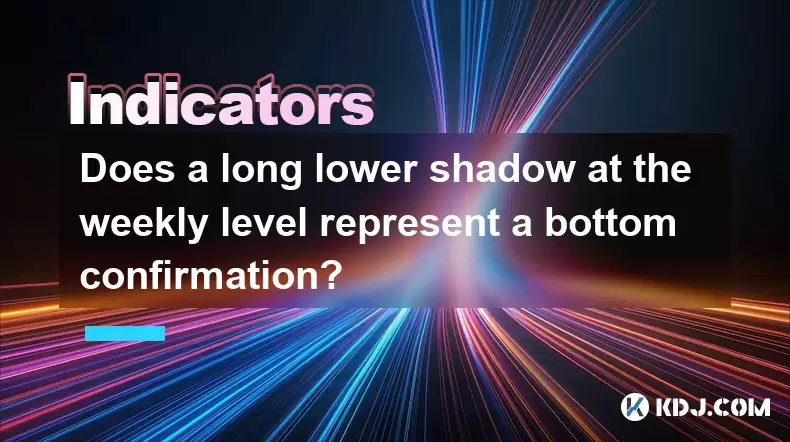
Does a long lower shadow at the weekly level represent a bottom confirmation?
Jun 27,2025 at 10:56am
Understanding the Weekly Lower Shadow in Candlestick AnalysisIn cryptocurrency trading, weekly candlestick patterns are often scrutinized for potential trend reversals. A long lower shadow at the weekly level indicates that during the week, sellers pushed prices down significantly but were met with strong buying pressure that closed the candle near its ...
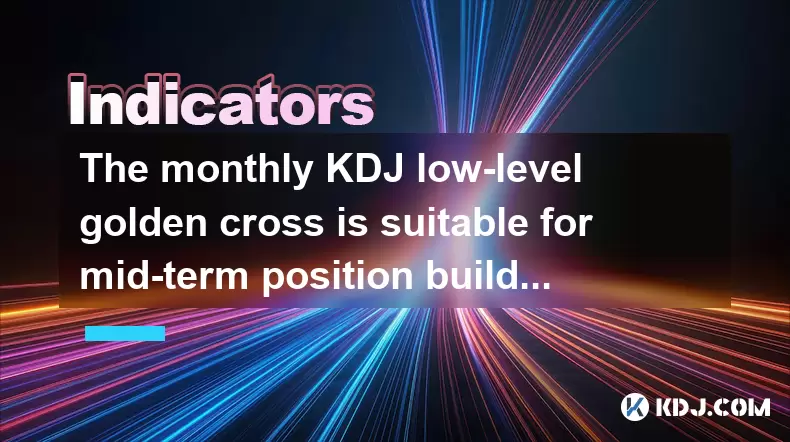
The monthly KDJ low-level golden cross is suitable for mid-term position building?
Jun 27,2025 at 03:14am
Understanding the Monthly KDJ IndicatorThe KDJ indicator, also known as the stochastic oscillator, is a momentum tool widely used in technical analysis within the cryptocurrency market. It consists of three lines: the K line, the D line, and the J line. These lines help traders identify overbought or oversold conditions, potential trend reversals, and e...
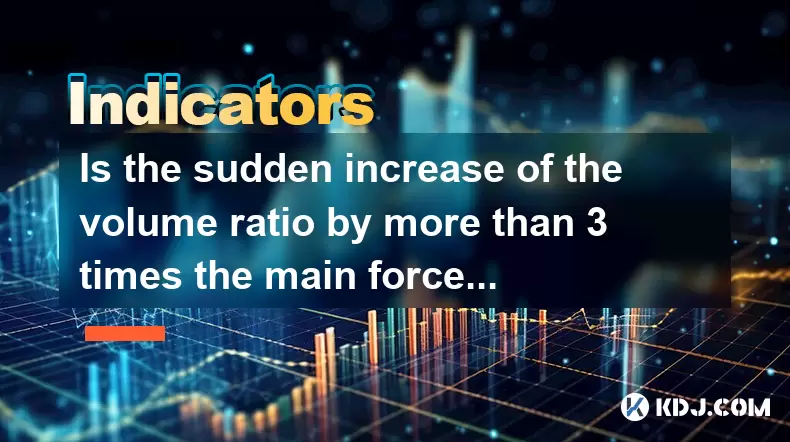
Is the sudden increase of the volume ratio by more than 3 times the main force entering the market?
Jun 27,2025 at 12:57pm
Understanding Volume Ratio in Cryptocurrency TradingIn cryptocurrency trading, the volume ratio refers to the comparison between the current trading volume and the average volume over a specific period, usually 20 or 30 days. This metric helps traders identify unusual market activity that could signal potential price movements. When the volume ratio inc...
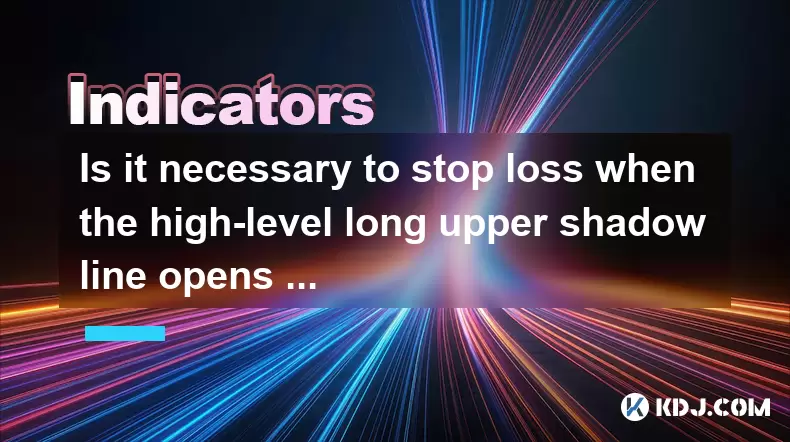
Is it necessary to stop loss when the high-level long upper shadow line opens low the next day?
Jun 27,2025 at 08:22am
Understanding the High-Level Long Upper Shadow LineIn technical analysis, a long upper shadow line refers to a candlestick pattern where the price moves significantly higher during the session but closes much lower, forming a long wick on the top. When this occurs at a high level, it suggests strong resistance and potential reversal. This type of candle...

Does the CCI indicator break through +200 mean that it is seriously overbought?
Jun 27,2025 at 01:08pm
Understanding the CCI Indicator and Its Relevance in Cryptocurrency TradingThe Commodity Channel Index (CCI) is a technical analysis tool widely used by traders in various financial markets, including cryptocurrency. Originally developed by Donald Lambert for commodities, it has since been adopted across asset classes to identify overbought or oversold ...

How lethal is the death cross of EXPMA12 and 50 lines?
Jun 27,2025 at 11:15am
Understanding the Death Cross in EXPMA IndicatorsThe death cross is a technical analysis pattern that signals a potential bearish trend reversal. In the context of the EXPMA (Exponential Moving Average), particularly when analyzing the crossover between the EXPMA12 and EXPMA50 lines, traders often interpret this as a strong sell signal. The death cross ...

Does a long lower shadow at the weekly level represent a bottom confirmation?
Jun 27,2025 at 10:56am
Understanding the Weekly Lower Shadow in Candlestick AnalysisIn cryptocurrency trading, weekly candlestick patterns are often scrutinized for potential trend reversals. A long lower shadow at the weekly level indicates that during the week, sellers pushed prices down significantly but were met with strong buying pressure that closed the candle near its ...

The monthly KDJ low-level golden cross is suitable for mid-term position building?
Jun 27,2025 at 03:14am
Understanding the Monthly KDJ IndicatorThe KDJ indicator, also known as the stochastic oscillator, is a momentum tool widely used in technical analysis within the cryptocurrency market. It consists of three lines: the K line, the D line, and the J line. These lines help traders identify overbought or oversold conditions, potential trend reversals, and e...

Is the sudden increase of the volume ratio by more than 3 times the main force entering the market?
Jun 27,2025 at 12:57pm
Understanding Volume Ratio in Cryptocurrency TradingIn cryptocurrency trading, the volume ratio refers to the comparison between the current trading volume and the average volume over a specific period, usually 20 or 30 days. This metric helps traders identify unusual market activity that could signal potential price movements. When the volume ratio inc...

Is it necessary to stop loss when the high-level long upper shadow line opens low the next day?
Jun 27,2025 at 08:22am
Understanding the High-Level Long Upper Shadow LineIn technical analysis, a long upper shadow line refers to a candlestick pattern where the price moves significantly higher during the session but closes much lower, forming a long wick on the top. When this occurs at a high level, it suggests strong resistance and potential reversal. This type of candle...
See all articles
























































































